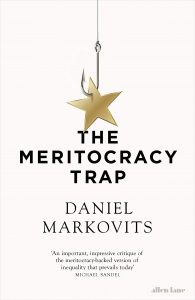In The Meritocracy Trap, Daniel Markovits argues that rather than aiding social mobility, the concept of meritocracy has become the single greatest obstacle to equal opportunities in the United States today. This provocative book marshals extensive evidence to show the tenacity of meritocracy’s narrative pull and how easy it is to get entangled in its logic, writes Phil Bell, yet its diagnosis is more compelling than its proposed solutions.
The Meritocracy Trap. Daniel Markovits. Penguin Press. 2019.
 Meritocracy is a reliable story. In The Meritocracy Trap, Daniel Markovits argues that this endlessly repeated cultural script is damaging partly because it is so consistent. The term ‘meritocracy’, where society is governed based on achievement, was coined by Michael Young in 1958 as a warning. Since then it has become the overwhelming organising principle of our education system and job market, leading to a proliferation of testing, a premium on college education and a fetishisation of credentials. Markovits’s The Meritocracy Trap is a radical critique of this logic and the institutions it has created. Meritocracy is seen by many as fair but, according to Markovits, it is more than counterproductive. Indeed, ‘meritocracy has become the single greatest obstacle to equal opportunities in America today.’
Meritocracy is a reliable story. In The Meritocracy Trap, Daniel Markovits argues that this endlessly repeated cultural script is damaging partly because it is so consistent. The term ‘meritocracy’, where society is governed based on achievement, was coined by Michael Young in 1958 as a warning. Since then it has become the overwhelming organising principle of our education system and job market, leading to a proliferation of testing, a premium on college education and a fetishisation of credentials. Markovits’s The Meritocracy Trap is a radical critique of this logic and the institutions it has created. Meritocracy is seen by many as fair but, according to Markovits, it is more than counterproductive. Indeed, ‘meritocracy has become the single greatest obstacle to equal opportunities in America today.’
The Meritocracy Trap is based on the author’s long-time personal experience of meritocracy as a Professor at Yale Law School and he sees the US as an extreme example of a broader global phenomenon. He marshals extensive evidence, from both interviews and academic research from numerous disciplines, referenced in detailed endnotes, to make a polemical case.
Markovits lays out substantial evidence to show that parenting and the education system are stacked in favour of the elites, guaranteeing their offspring human capital. This, he argues, is now more important than inheriting property or financial assets, because it reaps even more significant dividends. An elite education, which involves admission to a top preschool, a private secondary school, university and then graduate school, will likely confer an elite job with a six-figure salary. This investment in education, Markovits calculates, should earn an individual $10 million over their lifetime.

Markovits’s heroes are the middle class, the people who defined mid-century American social mobility but are now expelled from the ‘charismatic centre of economic and social life’ by meritocracy. In contrast to the British usage of this term, he uses middle class to encompass ‘working people without formal degrees or professions’: for example, a ‘unionised auto worker.’ Education is the key division between the middle class and elites. The middle class have not benefited from the substitution of in-work training by college education and the proliferation of job applications and job interviews, which have served to fetishise credentials and to benefit elites. St Clair Shores, a town in Michigan, was a microcosm of Markovits’s mid-century middle-class ideal. In this suburban town near Detroit, 18-year-olds were once hired by one of three big automakers for $100 per week (equivalent to $40,000 a year now). Without needing a degree from high school, a college degree or endless job applications, they were given unionised jobs and trained as tool and die makers. They could expect salaries to rise to up to $100,000 per year, with benefits. Meritocracy now suppresses this sort of opportunity and aspiration, Markovits argues.
However, in contrast to traditional analyses of inequality, Markovits sees highly skilled people on high incomes as equally consumed by meritocracy’s trap. Markovits talks to corporate lawyers who work 120-hour weeks and are under high pressure to maintain their place in the meritocratic system. Elites are really ‘high class conscripts’. However, Markovits goes further, arguing that ‘8 of 10 richest Americans today owe their wealth [ …] to compensation earned through entrepreneurial or managerial labor.’ Though these meritocrats primarily gain their wealth through wages, the extraordinary size of their salaries fuels inequality. Markovits’s analysis differs from other analyses of inequality, such as the equation at the heart of Thomas Piketty’s Capital in the Twenty-First Century: ‘R>G’ (when return on investment is greater than economic growth, this creates runaway inequality). Markovits does not emphasise the fact that, though high wages are earned, they are also multiplied through the mechanism Piketty articulates, creating inordinate wealth.
Crucially, though, the extraordinary work ethic of elites has changed the way inequality is justified. Meritocracy ‘frames disadvantage in terms of individual defects of skill and effort’ which serves to ‘dissolve resistance’ and leads to a ‘politics of humiliation’, where an inability to get a job or pay the rent is seen as a personal failure rather than a structural flaw. The suppressed anger this generates, in turn, opens the door to reactionary populist narratives that vilify meritocratic elites for self-serving hypocrisy and ‘in particular [… their] embrace of a multi-cultural elite’, given their unwillingness to acknowledge the unfairness of a credentialised meritocratic system. Cue Donald Trump’s famous line: ‘I love the poorly educated.’ Markovits also takes a different tack to those scholars who have written that the so-called ‘skills biased technological change’ will mean an inevitable hollowing out of middle-income jobs. This is all part of the plan, Markovits provocatively argues:
The appearance of super-skilled finance workers induced the innovations that then favoured their elite skills. A rising supply of meritocrats stimulates its own demand.
In other words, meritocrats are bending the skills needed for elite jobs in their favour.
Markovits shows the tenacity of meritocracy’s narrative pull and how easy it is to get entangled in its logic. He also demonstrates that our university and job admissions processes are in a bind. They simultaneously respect merit, but also recognise that merit is not a fair assessment. Markovits writes of groups of underrepresented university students that ‘meritocracy possesses such ideological power that these groups cannot decide whether to aim to bring down the class structure or to ease their members’ paths into the elite’. His analysis forces us to ask challenging questions: is education really a force for social mobility? Is affirmative action actually feeding into meritocracy’s all-pervasive logic?
Given how radical Markovits’s critique is, his solutions are surprisingly tame. The first reform dimension Markovits proposes is to make the education system fairer. Education ‘must become open and inclusive’, admissions ‘less competitive’ and ‘training less all-consuming’. Private schools and universities should lose tax-exempt status and Ivy League schools should be ‘doubling enrolments (drawing new students mostly from outside the elite)’. Secondly, ‘a parallel agenda’ would seek to rebalance the economy back in favour of ‘mid-skilled production’: for example, boosting jobs for ‘nurse-practitioners’ rather than doctors. This would involve wage subsidies for middle-class jobs and tax incentives, especially getting rid of the payroll tax (the 12.4 per cent tax on a person’s first $132,900 of wages that funds social security), which makes middle-class labour more highly taxed. These two prongs of policy show that ‘the rich and the rest cannot escape the meritocracy trap except jointly’.
This prognosis does not seem to follow from the analytical diagnosis offered in the preceding chapters. Markovits powerfully lays out that meritocracy itself is the trap. He argues that the knowledge economy is being curated by elites to exclude the middle class. However, none of these solutions decisively breaks with the power of meritocracy’s narrative. Indeed, it is not enough to provide policy solutions alone. Markovits has pointed out the power relations that shape the structural nature of meritocratic inequality, but his theory of how to change this offers no comment on power. He observes that ‘Policymakers [should…] always attend to how their choices will impact the balance between elite and middle-class jobs’, but he provides no explanation of the political forces necessary to make this change.
He does point out in the postscript to the UK edition that the UK Labour Party, under Jeremy Corbyn, shifted from talking about social mobility to social justice. But Markovits does not go into detail about what this may mean, or comment on the steps necessary to make this happen. How can we, as a society, compose non-meritocratic cultural scripts about self-worth, when the institutions which shape these narratives are run by meritocrats? Though Markovits provides a compelling list of policies, this is just solutionism that evades the problem so persuasively detailed in the book: that meritocracy is a system deliberately designed to prevent social mobility.
The Meritocracy Trap is a provocative book that views inequality and social mobility through a wide-ranging and interdisciplinary perspective. It offers challenging arguments to the traditional way in which the inequality story is told. Given how compelling this is, therefore, it is disappointing that a path to transforming meritocracy is not investigated with the author’s own theoretical framework in mind.
- This review originally appeared at the LSE Review of Books.
- Image Credit: Image by mohamed Hassan from Pixabay.
Please read our comments policy before commenting.
Note: This article gives the views of the authors, and not the position of USAPP– American Politics and Policy, nor of the London School of Economics.
Shortened URL for this post: https://bit.ly/2JDl9NC
About the reviewer
Phil Bell
Phil Bell is a teacher in London. He studied an MA in Education at UCL after training through the Teach First programme. He worked at Alec Reed Academy, Northolt and School 21, Stratford. He is particularly interested in lifelong education, the interaction between education and technology, and climate education.






